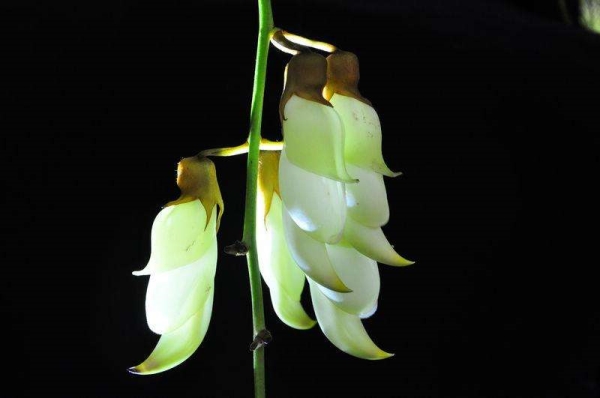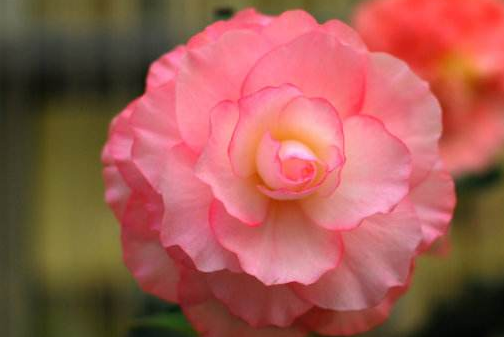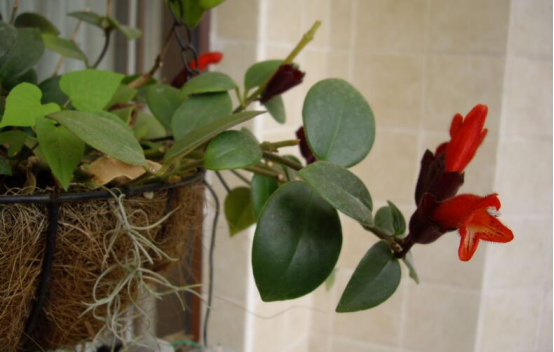Matters needing attention in breeding sparrow flowers
Sparrow flowers like fertilizer, so we should pay attention to the rational use of fertilizer, do not fertilize too much, resulting in root burning. Reasonable fertilization can ensure sufficient nutrients during the growth period, increase the leaf surface and thickness of the sparrow flower, and make the flower quality better when it blossoms.

Matters needing attention in how to raise sparrow flowers
Grass sparrow flowers bloom before and after Ching Ming Festival, hanging in a string like a sparrow flower flying, love everyone's love, but also many people raise their own at home. How to raise the sparrow flower? The following editor will share with you the points for attention in the breeding of sparrow flowers.
How to raise sparrow flowers
Soil: sparrow flowers like rich and moist soil, suitable for growing in deep sandy loam.
Humidity: like humid or semi-dry climate environment, the relative temperature of the air in the growing environment is required to be 50-70%. When the air relative humidity is too low, the lower leaves yellowing and falling off, and the upper leaves are not glossy.
Temperature: because it is native to the subtropics, the temperature in winter is very strict, and the growth stops when the ambient temperature is below 8 ℃.
Lighting: strong ability to adapt to light. Put in indoor maintenance, as far as possible in places with bright light, such as well-lit living room, bedroom, study and other places. After indoor maintenance for a period of time (about a month), it should be moved to an outdoor place with shade (heat preservation in winter) for a period of time (about a month), so alternately.
Fertilizer and water: spring, summer and autumn are its peak growing seasons. Fertilizer and water management circulates in the order of "Hua Bao"-- clear water-- "Hua Bao"-- clear water, with an interval of about 1-4 days. During the dormant period in winter, the main task is to control fertilizer and water. Fertilizer and water management circulates according to the order of "Huabao"-clear water-clear water-"Huabao"-clear water-clear water, the interval period is about 3-7 days, the interval period is shorter during sunny or high temperature, and the interval is longer or not watered during cloudy and rainy days or low temperature. For ground-planted plants, fertilizer and water were applied 2 to 4 times in spring and summer according to drought conditions: first, a small trench was opened at 30cm to 100cm outside the root neck (the larger the plant, the farther away from the root neck), the width and depth of the ditch were both 20cm. The ditch is sprinkled with 25-50 jin of organic fertilizer, or 1-5 two-grain compound fertilizer (chemical fertilizer), and then poured with water. After the beginning of winter, before the beginning of spring, fertilize again according to the above method, but do not need watering.
Pruning: when the plant enters the dormant or semi-dormant period in winter, the branches such as thin, disease and insect, withered and overdense should be cut off. The branches can also be arranged in combination with cuttings.
Matters needing attention in the culture of sparrow flower
The sparrow flower has strong sprouting ability and resistance to pruning. It should deal with overdense vines and senescent branches once in autumn to increase the light transmittance and promote the formation of flower buds.
How to raise sparrow flowers? This is the end of the points for attention in the breeding of sparrow flowers. Friends who are raising sparrow flowers at home will surely grow up healthily as long as they take good care of them in accordance with the above methods.
Culture methods and matters needing attention of Sparrow Flower
Latin name Mucuna birdwoodiana
Don't call it white flower oil, sesame vine, chicken blood vine.
The plant kingdom.
Phylum angiosperm
Dicotyledonous class
Subclass primitive perianth subclass
Mu Qiang Wei Mu
Suborder Rosa
Leguminosae
Subfamily Pteropodidae
Bean tribe
Genus Phaseolus
Distribution area tropical and subtropical Asia
Grass sparrow flower (Latin name: Mucuna birdwoodiana Tutch), also known as Baihua you Ma Teng, Hua Shan Ma Teng, sparrow flower. It is a second-class national protected plant, and the sparrow flower is a woody vine of the genus Lidopodium of the butterfly family. The sparrow flower is native to tropical and subtropical Asia and is cultivated in southern China. As the sparrow flowers are evergreen all the year round, they blossom before and after Ching Ming Festival, hanging in a string like a sparrow flower flying, which is of great ornamental value.
1. Morphological characteristics.
Evergreen, large woody vines. The bark of the old stem is grayish brown, the cross section is reddish brown, there are 3-4 eccentric concentric circles, the cross section flows white juice first, and the blood red juice is formed after 2-3 minutes; the young stem has longitudinal grooves, lenticels brown, protruding, glabrous or internodes covered with hairs. Pinnately compound leaves with 3 leaflets, 17-30 cm long; stipules caducous; petiole 8-20 cm long; leaf axis 2-4 cm long Leaflets subleathery, terminal leaflet elliptic, ovate or slightly Obovate, usually longer and narrower, 9-16 cm long, 2-6 cm wide, apex with acuminate up to 1.3-2 cm long, base rounded or slightly cuneate, lateral leaflets oblique, 9-16 cm long, both surfaces glabrous or scattered short hairs, lateral veins 3-5, midrib, lateral veins, reticulate veins raised on both surfaces; stipules absent. Petiolules 4-8 mm long, with sparse short hairs. Racemes on old branches or in leaf axils, 20-38 cm long, with 20-30 flowers, often fascicled; bracts ovate, ca. 2 mm, caducous; pedicels 1-1.5 cm long, with sparse or dense dark brown appressed hairs; bracteoles caducous Calyx inner and outer densely covered with light brown hair, outside by reddish brown shedding coarse bristles, calyx tube broadly cup-shaped, 1-1.5 cm long, 1.5-2.5 cm wide, 2 lateral teeth triangular, 5-8 mm long, lowest tooth narrowly triangular, 5-15 mm long, upper lip wide triangular, often as long as lateral teeth Corolla white or greenish white, flag petal 3.5-4.5 cm long, apex round, basal ear 4 mm long, wing petal 6.2-7.1 cm long, apex round, petal stalk about 8 mm long, densely covered with light brown short hairs, ears about 5 mm long, keel 7.5-8.7 cm long, basal petiole 7-8 mm long, ears no more than 1 mm long, densely covered with brown short hairs; staminal tube 5.5-6.5 cm long Ovary densely covered with erect dark brown short hairs. Fruit woody, banded, 30-45 cm long, 3.5-4.5 cm wide, 1-1.5 cm thick, near bead-shaped, densely reddish-brown tomentose, young fruit often covered with reddish-brown deciduous setae, with narrow woody wings 3-5 mm wide along dorsal and abdominal sutures, longitudinal grooves, and a woody septum between seeds, up to 4 mm thick Seeds 5-13, dark purple-black, subreniform, about 2.8 cm long, about 2 cm wide, 8-10 mm thick, often glossy, navel for seed perimeter of 1 inch 2-3 inch 4.
2. Growth habits
Sparrow flowers like warm and humid climate, shade and drought tolerance, fear of cold. Strong nature, rapid growth, strong climbing ability, flowering period from March to May, fruiting period from June to November, its vines climbing scaffolding growth in the garden, flowering inflorescence hanging under the shed, hanging in a string, more than 20-30 per string.
3. Geographical distribution
It produces Jiangxi, Fujian, Guangdong, Guangxi, Guizhou, Sichuan and other provinces and regions. Born in the mountain sun of 800 meters above sea level, by the side of the road, by the stream, often climbing on trees and shrubs.
4. Methods of reproduction
The sparrow flower can be propagated and raised by cutting and striping. The cuttings were carried out before sprouting in spring, the robust branches were selected as cuttings, and the lower end was soaked in rooting hormone solution such as rooting powder, and then inserted into the wet sand bed for sun shading and moisturizing, rooting for about 1 month, and outdoor cuttings in summer needed shade shelter. The striping mainly uses the fallen vine to cut the lower end of the Internode and press it into the soil to keep it moist and cut off the new plant after taking root. When used for planting or vertical greening, slow-acting fertilizers such as pond mud mixed with peat soil or garbage soil can be used to properly control plant growth. Sprouting is strong, and pruning, after the beginning of autumn, it should deal with overdense vines and senescent branches for one time, increase the light transmittance and promote the formation of flower buds.
The striping method selects strong branches and peels off the bark from about 15cm to 30cm below the top. The width of the peeled wound is about one centimeter, and the depth is limited to just peeling off the skin. Cut a piece of film 10 cm 20 cm long and 5 cm 8 cm wide, put some wet garden soil on it, and wrap it around like a wound. The upper and lower ends of the film are tightly tied and bulged in the middle. Take root in about four to six weeks. After taking root, cut off the root system along the edge of the branch to form a new plant.
When the softwood cuttage is carried out by the cutting method, the sturdy branches of the current year are selected as cuttings when the plants are growing vigorously from the end of spring to early autumn. After cutting off the branches, select the sturdy parts and cut them into segments 5-15 cm long, each with more than 3 leaf nodes. When cutting cuttings, it should be noted that the upper cut is cut flat at about 1 cm above the uppermost leaf node, and the lower cut is about 0.5 cm below the lowest leaf node, and the upper and lower cut should be flat (knife should be sharp). When hardwood cutting is carried out, after the temperature rises in early spring, the method of cutting is the same as that of softwood cutting.
5. Main value
As the grass sparrow flowers are evergreen all the year round, they bloom before and after Ching Ming Festival, hanging in strings as if they were flying, which is of considerable ornamental value, so it is most suitable for the top greening of large scaffolding, green corridors, green pavilions, open-field restaurants in parks and courtyards, etc.; suitable for vertical greening of walls, rockery balconies or slope protection flowers and trees; can also be used for rock, stone, forest configuration, quite natural wild interest. When greening the top surface, we should pay attention to setting up brackets and manual binding in the early stage to help it climb.
- Prev

Matters needing attention in the Culture of Begonia bulbosa
There are mainly three kinds of propagation of Begonia bulbosa: sowing propagation, cutting propagation and cutting tuber propagation. Sowing and reproduction can choose spring sowing or autumn sowing. Cutting propagation is mainly suitable in late spring and early summer. The main pests of Begonia bulb are thrips, aphids and leaf rollers.
- Next

Matters needing attention in family maintenance of saffron
1. Lipstick is a plant that watches flowers and leaves. Insufficient or excessive light of lipstick will affect its growth. Lack of light will cause lipstick to grow branches but not blossom. Excessive light will lead to redness and discoloration of lipstick leaves.
Related
- Fuxing push coffee new agricultural production and marketing class: lack of small-scale processing plants
- Jujube rice field leisure farm deep ploughing Yilan for five years to create a space for organic food and play
- Nongyu Farm-A trial of organic papaya for brave women with advanced technology
- Four points for attention in the prevention and control of diseases and insect pests of edible fungi
- How to add nutrient solution to Edible Fungi
- Is there any good way to control edible fungus mites?
- Open Inoculation Technology of Edible Fungi
- Is there any clever way to use fertilizer for edible fungus in winter?
- What agents are used to kill the pathogens of edible fungi in the mushroom shed?
- Rapid drying of Edible Fungi

